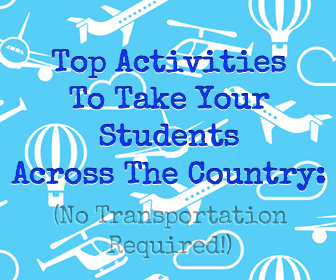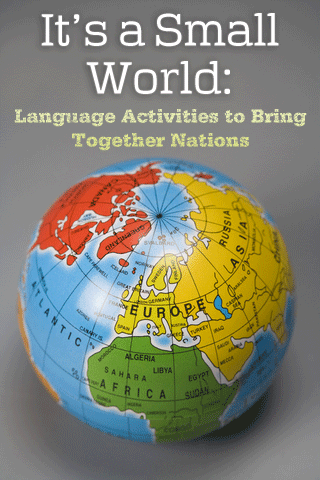Top Activities to Take Your Students Across the Country: No Transportation Required!


Many students, though they have studied English in their early education, travel overseas to further their studies at U.S. universities or language programs. These types of experiences tend to give individuals a larger perspective on the world and make them more sympathetic to people of other nations. You can use this international travel experience as a starting place for your class as you talk about different ways to bring the world to you.
One of Jules Vern’s most famous works of literature is the classic novel Around the World in 80 Days. In this story, Phileas Fogg takes a bet that he cannot travel around the world in 80 days or less. The book was first published in 1873, and at that time travel was not as easy as it is today. Fogg plans to travel mainly by ship and railroad but also ends up travelling in less traditional ways as he makes his way around the globe. As a class, brainstorm a list of all the possible ways a person could travel from one world city to another. Include traditional options like planes and busses as well as more outrageous ones like riding a bicycle and riding in a covered wagon. Once you have compiled an extensive list, ask each person to choose one unusual means of travel and write a story of how he or she might use that method to take a trip to another city. If you like, set your students to do some research about how and where a person may choose to travel by less traditional means. You may want to offer some suggestions such as riding a donkey, taking a hot air balloon or travelling by elephant (as Fogg did).
In 1980, David Springbett took a trip around the world using commercial airlines. His time eclipsed that of 80 days, but that does not mean it was uncomplicated. Springbett started his travels in Los Angeles and travelled to seven other cities before returning to Los Angeles 44 hours and six minutes later. The cities he stopped in on his travels were London, Bahrain, Singapore, Bangkok, Manila, Tokyo, and Honolulu, in that order. Have your class trace Springbett’s travels on a world map, and then set groups of students to answer some questions. What was the longest distance he travelled on one flight? What languages are spoken in each of the cities where he stopped? If he had stopped for a meal in each of the cities, what might Springbett have eaten? If you like, divide your class into seven groups and assign one city to each group. You might also ask these groups to share some unusual facts about the cities they research. Once groups have discovered answers to these questions, bring the class back together for a discussion. What do your students think about Springbett’s trip? Would they like to make a similar trip around the world? Why do people like to travel to foreign cities? What advantages can your students list that travel brings? What are its disadvantages? What were their experiences travelling overseas? You can also have the class work together to determine who made the longest trip both in time and in miles to reach your facility. If you want to bring an additional challenge to your class, divide your students into groups of around three students each and challenge them to plan their own flight around the world. They should consider which cities they would like to visit, how many miles they would have to travel and how long the trip might take if they used commercial airlines as Springbett did.
The United Nations is one of the most important organizations in the world today. Their first General Assembly was held in London on January 10, 1946, and in 1952, the United Nations moved to New York City to land donated by John D. Rockefeller. Set your students to do some research about the United Nations. They can find some basic information about the United Nations at their website. Among the vast amount of information there are listed the four purposes of the U.N.: to keep world peace, to develop friendly relations among nations, to help the peoples of the world, and to be a center to make these things happen. In groups, have your students discuss why each of these items is important and then brainstorm ways the United Nations helps make these things possible. Then ask your students to think of ways they can help accomplish each of these goals in your classroom and with one another. Have each group choose one of the strategies they list and develop a plan to make it happen in your classroom. Then have each group present their idea to the class. The presentation should include an explanation of the idea, how to make it happen in the classroom and why it would be beneficial to your class and to the world.
With these activities that take your students around the globe, they can increase their appreciation for one another and one another’s cultures, in effect, doing their own small part in making the world a better place.